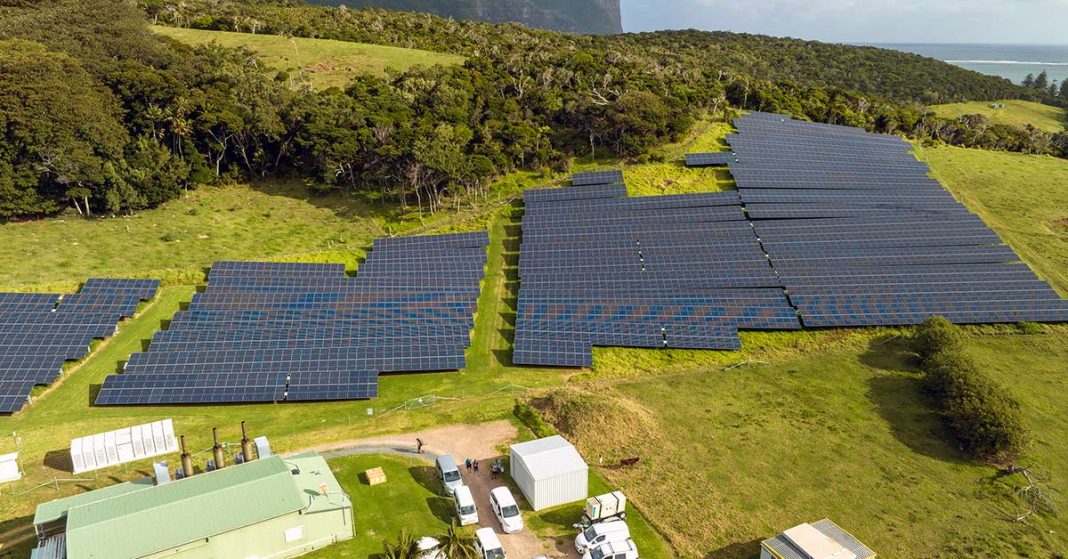Republished Story from the e-Journal Renew Economy
(Updated by Suzie Christensen, CEO, Lord Howe Island Board)
A solar and battery-based microgrid installed on the World Heritage-listed Lord Howe Island on the coast of Australia in the Tasman Sea delivered more than $1.5 million in diesel fuel cost savings in its first two years of operation, a new report has revealed.
Commissioned in April 2021, the Hybrid Renewable Energy Project (HREP) was installed to provide a sustainable supply of electricity for the 400 residents and up to 400 tourists on Lord Howe Island, slashing its reliance on costly and polluting diesel fuel generation.
The $11.1 million project, developed by Photon Energy and backed by the Australian Renewable Energy Agency (Arena) installed 1.3MW of solar with a 3.7MWh Tesla battery energy storage system and micro-grid controller, alongside the existing diesel system of three 300kW generating units.
It received $4.5 million in funding from Arena, while the Lord Howe Island Board secured a NSW government loan of $5.9 million, providing the remaining balance of funds from its own capital.
Within its first six months of operation, the microgrid proved its worth, with reports emerging that the solar and battery system had navigated stretches of up to five days and nights powering the Island without any additional diesel-generated back-up.
But in a knowledge sharing report published this week, Arena says the project has outperformed expectations on a number of fronts, including the average amount of renewables it supplies, forecast at 67%. And it has saved the Island hundreds of thousands of dollars a year.
“Over the first 12-months of operation, HREP supplied approximately 1,587 MWh of renewable energy to the LHI grid. The average RE penetration was 73%,” the report says.
“Over the second 12-months of operation, HREP supplied 1,654 MWh of renewable energy to the LHI grid with an average RE penetration of 67.93% … owing largely to the wet autumn.”
The report also says that the microgrid saved 349,082 litres of diesel in the first year, delivering $740,054 in fuel cost savings based on an average supply price of 2.12 $/L (GST exc.). During the second, 360,236 litres of diesel was saved, delivering $815,641 in fuel cost savings based on an average supply price of 2.26 $/L (GST exc.) – a total saving of around $1.55 million over two years.
The report also notes that the microgrid caused “zero interruptions” to the Island’s power supply during the reporting period.
“The hybrid renewable energy project has improved Lord Howe’s self-sufficiency whilst also reducing the Island’s reliance on diesel generators and imported fuels,” the report says.
“The project has enabled skill development by power station operators, LHIB personnel and Island residents. The partnership with Arena means that knowledge about the Island’s hybrid renewable energy microgrid will be shared to the benefit of other remote communities in the future.”
Less emissions, but increased total costs
(by Suzie Christensen, CEO, Lord Howe Island Board)
The report highlights reduced use of diesel, which is great for the environment.
Average diesel savings in litres has been 389,946 per year over three years of operations and the four years prior on full diesel generation. That equates to roughly 1000 tonnes of CO2E emissions, a significant contribution from a small community.
The report has referenced projected cost savings based on projected diesel savings. However, the actual dollar savings are far less, largely because of a ‘minimum freight on diesel’ clause in the current marine freight contract.
The actual average diesel costs saving has been $387,358 per year due to the minimum freight requirements versus a potential average saving of $602,926 per year without the freight charge.
These figures also don’t account for an additional $126,000 in interest payments or the average increase of $639,752 per year in depreciation to replace the assets. Maintenance and salaries have remained stable.
Operationally, based on those averages, electricity generation and supply for the Island is 43% more expensive than prior to the solar installation, even with the grant from Arena. The Board’s electricity charges have only increased 10% from 2021 to 2024 in that time.
An Electricity Strategy will be developed in the coming years, with a long-term focus on achieving affordable electricity for residents and businesses while striving to meet goals to reduce emissions.


